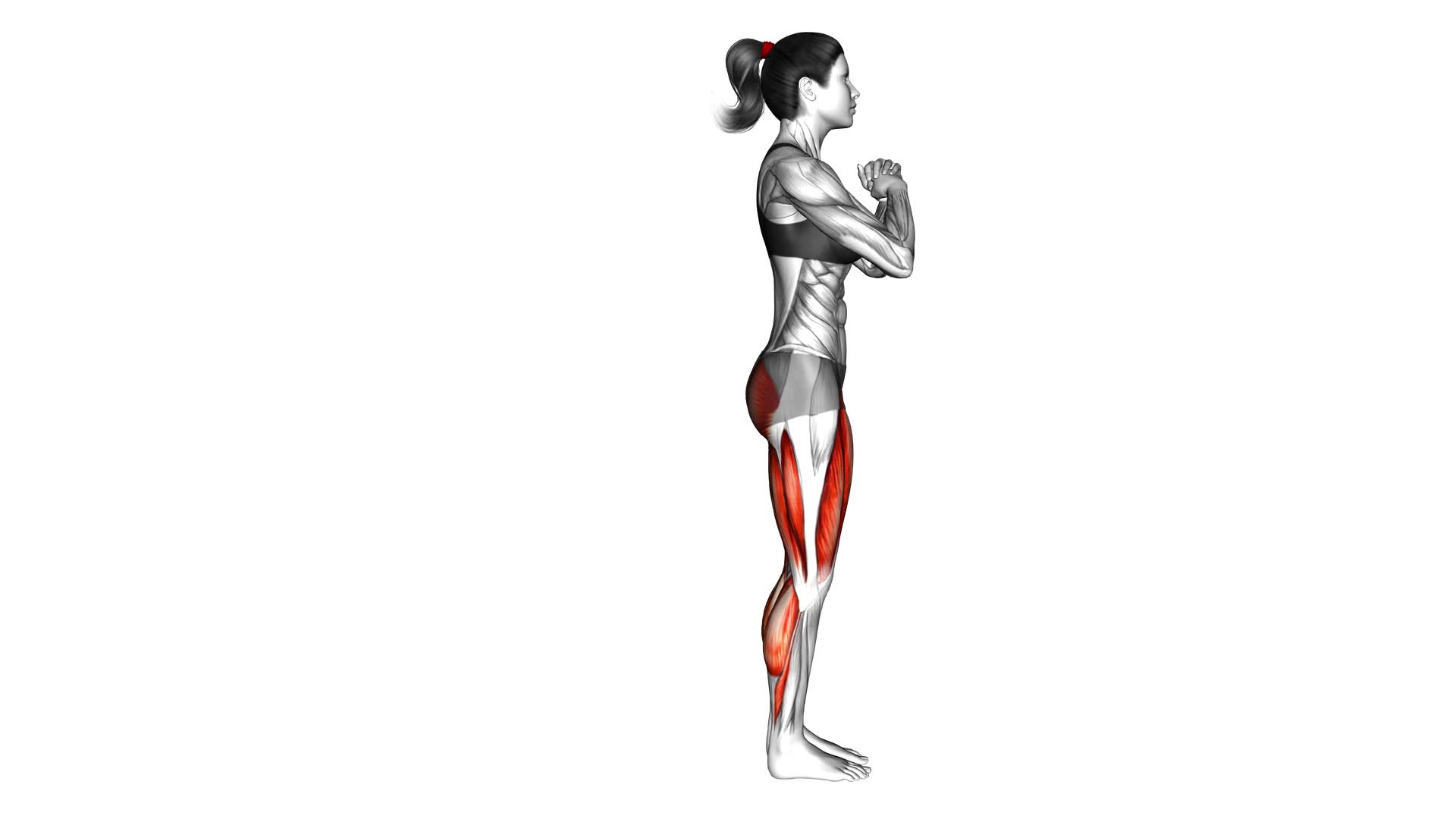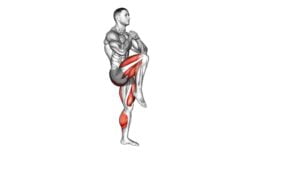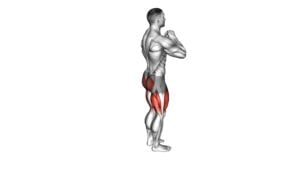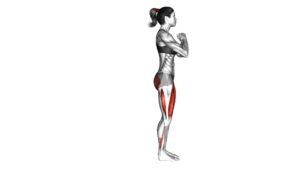Bodyweight Reverse Lunge High Knee (female) – Video Exercise Guide & Tips

Looking to tone your legs and improve your overall fitness level? Try the bodyweight reverse lunge high knee exercise!
Watch This Exercise Video
This video exercise guide will show you the proper form and technique for this effective movement.
Whether you're a beginner or advanced, there are tips and variations to suit your fitness level.
Avoid common mistakes and incorporate this exercise into your routine for maximum results.
Get ready to challenge yourself and achieve your fitness goals with the bodyweight reverse lunge high knee!
Key Takeaways
- The Bodyweight Reverse Lunge High Knee exercise improves balance and increases lower body strength.
- It targets leg muscles such as quadriceps, hamstrings, and glutes, engaging them in a different way than traditional lunges.
- Proper form and technique include shoulder-width foot placement, aligned knees and ankles, avoiding leaning too far forward, and keeping the back straight.
- Foot placement is important, starting with feet hip-width apart and adjusting based on fitness level. Beginners can start with a narrower stance, while advanced individuals can try a wider stance.
Benefits of the Bodyweight Reverse Lunge High Knee
You can experience numerous benefits from incorporating the bodyweight reverse lunge high knee into your workout routine. This exercise is highly effective in improving balance and increasing lower body strength.
By performing the bodyweight reverse lunge high knee, you challenge your leg muscles, including your quadriceps, hamstrings, and glutes. This exercise requires you to step backward into a lunge position and then elevate your knee towards your chest. This movement engages your muscles in a different way than traditional lunges, leading to increased lower body strength.
Additionally, the bodyweight reverse lunge high knee helps to improve your balance. As you step back into the lunge and elevate your knee, you must engage your core muscles to maintain stability. By practicing this exercise regularly, you can enhance your body's ability to stay balanced, which can be beneficial in various daily activities and sports.
Incorporating the bodyweight reverse lunge high knee into your workout routine is a time-efficient way to target multiple muscle groups while also improving balance. Whether you're an athlete looking to enhance your performance or someone who wants to increase lower body strength, this exercise is a valuable addition to your fitness regimen.
Proper Form and Technique for the Exercise
When performing the Bodyweight Reverse Lunge High Knee exercise, proper foot placement is crucial. By ensuring that your feet are shoulder-width apart and that your knees are aligned with your ankles, you can maintain stability and prevent injury.
Additionally, it's important to avoid common mistakes such as leaning too far forward or allowing your knee to extend past your toes, as this can strain your joints and reduce the effectiveness of the exercise.
Foot Placement Importance
To maximize the effectiveness of the Bodyweight Reverse Lunge High Knee exercise, pay attention to your foot placement. Proper foot placement is crucial for maintaining balance and stability throughout the movement.
When performing this exercise, start by standing with your feet hip-width apart. As you step back into the reverse lunge, make sure to keep your front foot firmly planted on the ground. Your back foot should be positioned with the ball of your foot touching the ground, allowing for a smooth transition into the high knee movement.
Remember, the positioning of your feet may vary depending on your fitness level. Beginners can start with a narrower stance, while more advanced individuals can try a wider stance to increase the challenge.
Common Mistakes to Avoid
To ensure proper form and technique for the Bodyweight Reverse Lunge High Knee exercise, it's important to be mindful of these common mistakes:
- Leaning too far forward: Avoid leaning too far forward during the lunge as it can put excessive strain on your knees and lower back, increasing the risk of injury.
- Not maintaining a straight back: Keep your back straight throughout the movement to ensure proper alignment and prevent unnecessary stress on your spine.
- Landing too forcefully on your front foot: When performing the high knee movement, aim to land softly on your front foot to reduce impact and protect your joints.
By avoiding these common mistakes, you can minimize the risk of injury and perform the exercise more effectively.
Now, let's move on to the next section to learn some tips for beginners to master the movement.
Tips for Beginners to Master the Movement
Start by focusing on your balance and stability while performing the Bodyweight Reverse Lunge High Knee exercise. As a beginner, it's important to understand that this exercise can be modified to suit your fitness level.
One common misconception is that you need to perform the exercise quickly to get the most out of it. However, it's more important to focus on proper form and control rather than speed.
To modify the exercise, you can start by performing the movement without the high knee component. This will allow you to focus on your balance and stability during the reverse lunge. Once you feel comfortable with the movement, you can gradually incorporate the high knee.
Another beginner modification is to use a chair or wall for support. This can provide additional stability as you work on your balance. You can lightly hold onto the chair or wall for support while performing the exercise.
Remember to engage your core and maintain a neutral spine throughout the movement. It's also important to keep your chest lifted and avoid leaning forward.
Advanced Variations to Challenge Your Fitness Level
Ready to take your fitness level up a notch? Try incorporating some advanced variations of the bodyweight reverse lunge high knee exercise.
One option is to add a jump lunge progression, which will challenge your balance and explosiveness.
Another option is to introduce weighted reverse lunges, using dumbbells or a barbell, to increase the resistance and further strengthen your lower body.
These advanced variations will push you to new heights and help you achieve your fitness goals.
Jump Lunge Progression
Challenge your fitness level with advanced variations of jump lunges. These modifications will take your lunge game to the next level, targeting your lower body strength and elevating your heart rate. Here are three exciting variations to try:
- Jump Lunge Plyo: Increase the intensity by adding a plyometric element to your jump lunges. Explode off the ground with each lunge, switching legs mid-air and landing softly in a lunge position. This explosive movement will power up your muscles and boost your cardiovascular endurance.
- Weighted Jump Lunge: Grab a pair of dumbbells or a weighted vest to add resistance to your jump lunges. The added weight will challenge your muscles even more, helping you build strength and definition in your thighs and glutes.
- 180-Degree Jump Lunge: Take a 180-degree turn in mid-air during your jump lunges. This dynamic movement engages your core muscles and improves your agility and balance.
Incorporating these advanced jump lunge variations into your workouts will keep you motivated, push your limits, and take your fitness to new heights.
Weighted Reverse Lunges
To further challenge your fitness level, incorporate weighted reverse lunges into your routine. Weighted lunges add an extra level of difficulty and intensity to the exercise, helping you build strength and endurance in your lower body.
There are several variations of weighted reverse lunges that you can try to keep your workouts interesting and constantly challenge your muscles. You can hold dumbbells by your sides or use a barbell across your shoulders to increase the resistance. Another option is to use a weighted vest or ankle weights for added intensity.
By incorporating these reverse lunge variations into your routine, you'll be able to target different muscles and continue to progress in your fitness journey.
Now, let's move on to the next section and learn about common mistakes to avoid during the exercise.
Common Mistakes to Avoid During the Exercise
Ensure that you maintain proper form and avoid these common mistakes during the Bodyweight Reverse Lunge High Knee exercise.
- Lack of balance: Balance plays a crucial role in this exercise. Failing to maintain a stable position can lead to wobbling or even falling over. Focus on engaging your core and keeping your weight centered throughout the movement.
- Incorrect knee alignment: Improper knee alignment can put unnecessary strain on the joints. Make sure that your knees stay in line with your toes during both the lunge and high knee phases. This will help protect your knees and prevent discomfort or injury.
- Overstriding: Taking excessively long strides during the reverse lunge can cause instability and make it harder to maintain balance. Take smaller steps and keep your movements controlled to ensure proper form and stability.
By avoiding these common mistakes, you can maximize the effectiveness of the Bodyweight Reverse Lunge High Knee exercise and reduce the risk of injury.
Now, let's explore how you can incorporate this exercise into your workout routine.
Incorporating the Bodyweight Reverse Lunge High Knee Into Your Workout Routine
To incorporate the Bodyweight Reverse Lunge High Knee into your workout routine, start by performing 3 sets of 10 repetitions on each leg. This exercise is a great way to target your lower body muscles, including your quadriceps, hamstrings, glutes, and calves, while also engaging your core and improving balance.
When performing the Bodyweight Reverse Lunge High Knee, it's important to maintain proper form to maximize its effectiveness and prevent injury. Begin by standing tall with your feet hip-width apart. Take a step back with one foot, lowering your body into a lunge position. Make sure your front knee is aligned with your ankle and not extending past it. As you push off with your back foot, drive your knee up towards your chest in a high knee motion. Repeat the movement on the other leg.
To add variety to your workout routine, you can try different variations of the Bodyweight Reverse Lunge High Knee. One option is to hold a dumbbell in each hand to increase the resistance and challenge your muscles further. Another variation is to perform the exercise on an unstable surface like a balance board or BOSU ball, which will engage your stabilizer muscles even more.
Incorporating the Bodyweight Reverse Lunge High Knee into your workout routine won't only strengthen your lower body but also improve your balance and stability. Remember to start with proper form and feel free to explore different variations to keep your workouts exciting and challenging.
Frequently Asked Questions
How Many Calories Does the Bodyweight Reverse Lunge High Knee Burn?
Bodyweight plays a significant role in determining the calorie burn of the reverse lunge high knee. The more bodyweight you have, the more calories you'll burn during this exercise.
However, it's important to note that the bodyweight reverse lunge high knee may not be suitable for beginners. It requires a certain level of strength and stability.
It's recommended to start with lighter exercises and gradually progress to this one.
Can Men Also Perform the Bodyweight Reverse Lunge High Knee Exercise?
Yes, men can also perform the bodyweight reverse lunge high knee exercise.
It's a great exercise for men as it helps to strengthen the lower body muscles and improve balance and stability.
By incorporating this exercise into your workout routine, you can target your quadriceps, hamstrings, glutes, and core muscles.
Additionally, it can also help to improve your cardiovascular endurance and burn calories.
What Are Some Alternative Exercises to the Bodyweight Reverse Lunge High Knee?
Looking for alternative exercises to the bodyweight reverse lunge high knee?
There are a few options you can try.
One alternative is the walking lunge, which targets similar muscles and improves balance.
Another option is the step-up exercise, which strengthens your legs and core.
Both of these exercises provide cardiovascular benefits similar to the bodyweight reverse lunge high knee.
Give them a try and see which one works best for you!
How Often Should I Incorporate the Bodyweight Reverse Lunge High Knee Into My Workout Routine?
To effectively incorporate the bodyweight reverse lunge high knee into your workout routine, consider factors such as your fitness level and goals. Start by performing the exercise 2-3 times per week.
Hold the lunge position for 1-2 seconds before driving your knee up. This exercise targets various muscle groups, including the quadriceps, glutes, and core.
Remember to maintain proper form and gradually increase the intensity as you progress. Always listen to your body and adjust the frequency based on your individual needs.
Can the Bodyweight Reverse Lunge High Knee Help Improve Balance and Stability?
The bodyweight reverse lunge high knee exercise can definitely help improve your balance and stability. By incorporating bodyweight exercises into your routine, you engage your core muscles and challenge your balance.
This exercise specifically targets your lower body and requires coordination, which can enhance your stability. If you're a beginner, you can modify the bodyweight reverse lunge high knee by performing it without the high knee movement or by using a support like a chair for balance.
Conclusion
The bodyweight reverse lunge high knee is a beneficial exercise that can be incorporated into your workout routine. It helps improve lower body strength, balance, and coordination.
By following proper form and technique, beginners can master the movement and gradually progress to advanced variations. It's important to avoid common mistakes and listen to your body to prevent injuries.
Include this exercise in your routine to challenge your fitness level and achieve your goals.

Author
Years ago, the spark of my life’s passion ignited in my mind the moment I stepped into the local gym for the first time. The inaugural bead of perspiration, the initial endeavor, the very first surge of endorphins, and a sense of pride that washed over me post-workout marked the beginning of my deep-seated interest in strength sports, fitness, and sports nutrition. This very curiosity blossomed rapidly into a profound fascination, propelling me to earn a Master’s degree in Physical Education from the Academy of Physical Education in Krakow, followed by a Sports Manager diploma from the Jagiellonian University. My journey of growth led me to gain more specialized qualifications, such as being a certified personal trainer with a focus on sports dietetics, a lifeguard, and an instructor for wellness and corrective gymnastics. Theoretical knowledge paired seamlessly with practical experience, reinforcing my belief that the transformation of individuals under my guidance was also a reflection of my personal growth. This belief holds true even today. Each day, I strive to push the boundaries and explore new realms. These realms gently elevate me to greater heights. The unique combination of passion for my field and the continuous quest for growth fuels my drive to break new ground.







